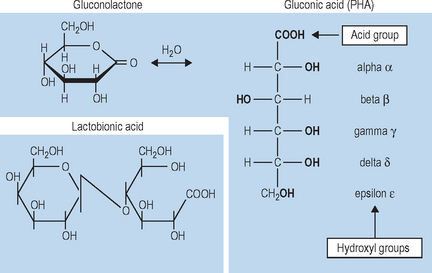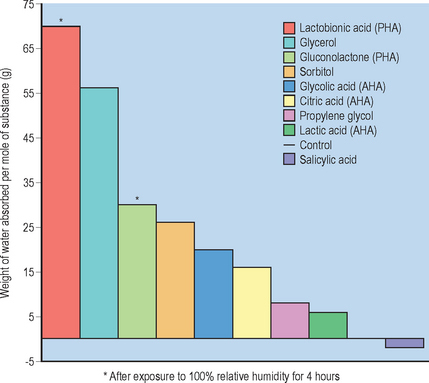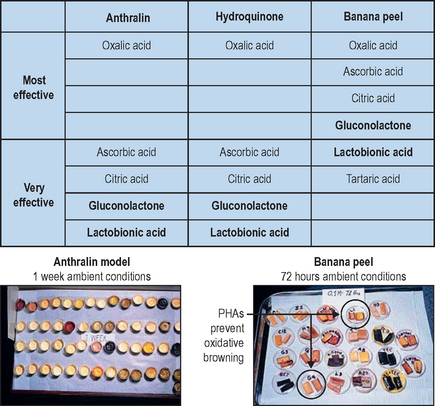Chapter 33 PHAs and Bionic Acids: Next Generation Hydroxy Acids
INTRODUCTION
• The PHA and bionic structure
Polyhydroxy acids and bionic acids are organic carboxylic acids, which possess two or more hydroxyl groups on an aliphatic or alicyclic molecular structure. When one of the hydroxyl groups occurs in the alpha position, the PHA is a polyhydroxy AHA Fig. 33.1; when an additional sugar is attached to the PHA structure, the molecule is a bionic acid (Fig. 33.1). Because they share the common AHA structure, PHAs and bionics have the ability to provide skin effects similar to traditional AHAs, such as glycolic acid.
GLUCONOLACTONE: A REPRESENTATIVE PHA
Gluconolactone (gluconic acid delta lactone) is a nontoxic, naturally occurring component of the skin. The molecule’s somewhat larger size (molecular weight 178 vs. 76 for glycolic acid) facilitates a gradual penetration into skin, thus minimizing irritation. The smaller molecule of glycolic acid penetrates the skin more rapidly, often causing stinging and burning. Gluconolactone’s potential for increased hydration is attributed to humectant properties of the multiple hydroxyl groups, which can attract and hydrogen bond water Fig. 33.2.
• Antioxidant and free radical scavenging effects of gluconolactone
The antioxidant properties of gluconolactone are evident in food and drug substances, in which gluconolactone has been shown to inhibit oxidation and help maintain product integrity Fig. 33.3.
• Clinical effects of gluconolactone
In vivo clinical studies of gluconolactone-containing formulations have demonstrated measurable benefits including antiaging and skin-firming effects that are comparable to commonly used AHAs (e.g. glycolic acid), with reduced irritation potential. In addition, significant antiaging benefits including reduced pigmentation and improved skin texture have been observed over a range of darker Fitzpatrick skin types (IV–VI) represented by a study population of African–Americans, Asians, and Hispanics.
Gluconolactone is well suited for adjunctive use with topical medications. It enhances epidermal cell turnover, which may in part help to explain the adjunctive benefits of PHAs in the treatment of acne. A vehicle-controlled, double-blind clinical study on mild to moderate acne demonstrated antiacne effects with less irritation of a 14% gluconolactone solution in comparison to a 5% benzoyl peroxide lotion. In addition, PHAs can be used to hydrate and condition skin during treatment with drying or irritating medications including topical retinoids, benzoyl peroxide, and azelaic acid. This benefit was demonstrated in a clinical study designed to evaluate the effects of standardized adjunctive use of a PHA cleanser plus PHA moisturizer in combination with 15% azelaic acid gel for the treatment of rosacea. Results indicated significantly greater improvements in global assessment and erythema relative to the azelaic acid treatment group that had not been standardized to adjunctive PHAs (P < 0.05). Compatibility of a 15% gluconolactone-containing cream (pH 3.3) in combination with daily use of tretinoin gel 0.1% has also been demonstrated.
Stay updated, free articles. Join our Telegram channel

Full access? Get Clinical Tree









